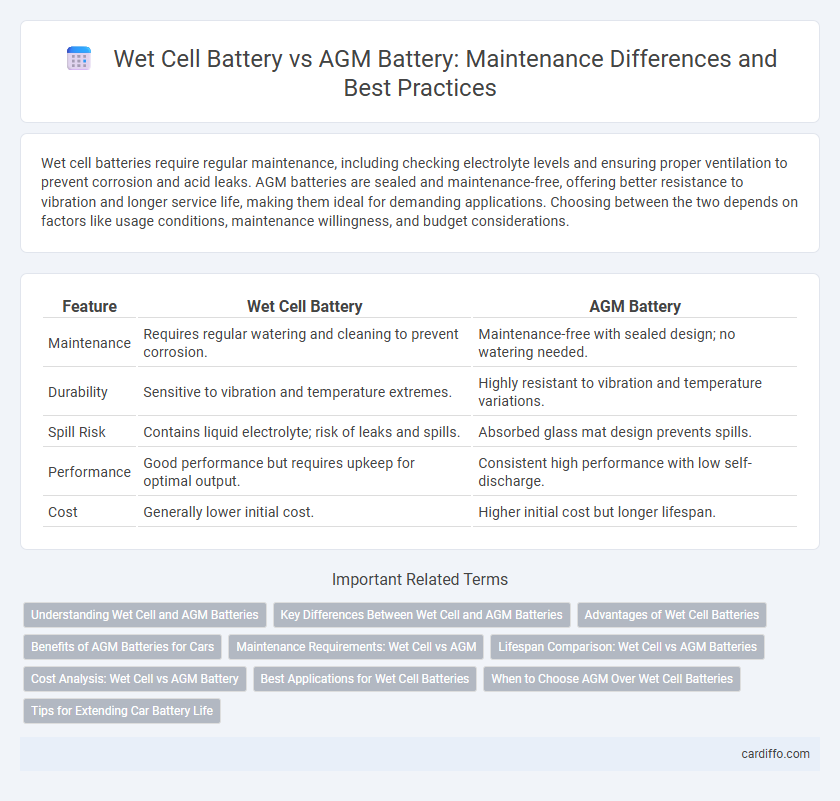Wet cell batteries require regular maintenance, including checking electrolyte levels and ensuring proper ventilation to prevent corrosion and acid leaks. AGM batteries are sealed and maintenance-free, offering better resistance to vibration and longer service life, making them ideal for demanding applications. Choosing between the two depends on factors like usage conditions, maintenance willingness, and budget considerations.
Table of Comparison
| Feature | Wet Cell Battery | AGM Battery |
|---|---|---|
| Maintenance | Requires regular watering and cleaning to prevent corrosion. | Maintenance-free with sealed design; no watering needed. |
| Durability | Sensitive to vibration and temperature extremes. | Highly resistant to vibration and temperature variations. |
| Spill Risk | Contains liquid electrolyte; risk of leaks and spills. | Absorbed glass mat design prevents spills. |
| Performance | Good performance but requires upkeep for optimal output. | Consistent high performance with low self-discharge. |
| Cost | Generally lower initial cost. | Higher initial cost but longer lifespan. |
Understanding Wet Cell and AGM Batteries
Wet cell batteries use a liquid electrolyte solution to facilitate electrical charge storage and require regular maintenance to check electrolyte levels and prevent corrosion. AGM (Absorbent Glass Mat) batteries utilize a fiberglass mat to absorb the electrolyte, providing a sealed, spill-proof design with greater resistance to vibration and longer cycle life. Understanding the differences in construction and maintenance needs between wet cell and AGM batteries is crucial for optimal performance and longevity in various applications.
Key Differences Between Wet Cell and AGM Batteries
Wet cell batteries use liquid electrolyte and require regular maintenance like checking water levels, while AGM (Absorbent Glass Mat) batteries contain electrolyte absorbed in glass mats, making them spill-proof and maintenance-free. AGM batteries offer better resistance to vibration, faster charging, and deeper discharge capabilities compared to wet cell batteries, making them ideal for high-performance applications. However, wet cell batteries typically cost less and are more suited for traditional automotive uses where maintenance is regularly performed.
Advantages of Wet Cell Batteries
Wet cell batteries offer cost-effective maintenance and easy accessibility for electrolyte refills, making them ideal for users prioritizing affordability and hands-on upkeep. Their robust design allows for better tolerance to overcharging and heat, which can extend battery life in harsh operating conditions. These batteries excel in applications requiring high surge currents and easy repairability compared to sealed AGM systems.
Benefits of AGM Batteries for Cars
AGM batteries offer superior vibration resistance and faster charging capabilities compared to traditional wet cell batteries, enhancing vehicle reliability and startup performance. Their sealed design prevents acid leakage and reduces maintenance needs, making them ideal for modern cars with advanced electrical systems. Enhanced cold-cranking amps (CCA) in AGM batteries improve engine starting power, especially in extreme weather conditions.
Maintenance Requirements: Wet Cell vs AGM
Wet cell batteries require regular maintenance such as checking electrolyte levels and refilling distilled water to prevent damage and ensure longevity. AGM batteries are maintenance-free, with sealed construction that prevents electrolyte evaporation and eliminates the need for water refills. This makes AGM batteries more convenient for users seeking low-maintenance power solutions in vehicles and backup systems.
Lifespan Comparison: Wet Cell vs AGM Batteries
Wet cell batteries typically have a lifespan of 3 to 5 years, but their performance can be significantly affected by deep discharges and maintenance practices. AGM (Absorbent Glass Mat) batteries generally offer a longer lifespan, ranging from 4 to 7 years, due to their sealed design and superior resistance to vibration and sulfation. Proper maintenance extends wet cell battery life, while AGM batteries require minimal upkeep, making them more durable in demanding applications.
Cost Analysis: Wet Cell vs AGM Battery
Wet cell batteries typically cost 20-40% less than AGM batteries, making them a more budget-friendly option for basic applications. AGM batteries offer longer lifespan and lower maintenance costs, which can offset their higher initial investment over time. When evaluating total cost of ownership, factors like replacement frequency and vehicle energy demands significantly influence whether the higher upfront price of AGM batteries proves more economical.
Best Applications for Wet Cell Batteries
Wet cell batteries excel in applications requiring high cranking power and frequent deep discharges, such as in traditional automobiles, motorcycles, and marine vessels. Their robust design allows for easy maintenance and cost-effective replacement in environments exposed to vibration and varying temperatures. Wet cell batteries remain preferred for heavy-duty use where affordable and reliable energy storage is critical.
When to Choose AGM Over Wet Cell Batteries
AGM batteries are preferred over wet cell batteries when maintenance-free operation and superior vibration resistance are required, especially in applications like marine, off-road, or high-performance vehicles. Their sealed design prevents acid spillage, making them safer for indoor or confined spaces. AGM batteries also perform better in extreme temperatures and offer faster recharge times, making them ideal for environments demanding reliability and efficiency.
Tips for Extending Car Battery Life
Regularly cleaning battery terminals and ensuring tight, corrosion-free connections significantly improve the performance and longevity of both Wet Cell and AGM batteries. Maintaining proper charging habits, such as avoiding deep discharges and using a compatible charger for each battery type, prevents premature capacity loss. Storing batteries in a cool, dry environment reduces self-discharge rates and preserves overall battery health.
Wet Cell Battery vs AGM Battery Infographic

 cardiffo.com
cardiffo.com